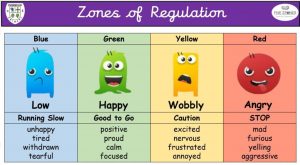
Teaching Zones of Regulation to Children
Teaching Zones of Regulation to Children
Emotions and feelings are quite hard for all of us to manage. So, imagine how difficult it is for your child. In other words, learning to identify and manage one’s feelings is a big task for children. So, Ms. Leah Kuypers an OT specializing in Autism developed a curriculum. This is called the “Zones of Regulation”. Further, this curriculum offers resources to teach kids to identify and manage their emotions. So, let’s talk about teaching zones of regulation to children in this blog. Let’s first get some background on the zones of regulation curriculum.
What is the Zone of Regulation Program?
This is an approach focusing on helping kids identify and deal with their feelings. Further, it is a cognitive-behavioral approach. In other words, it teaches strategies for self-regulation. The various emotional states are segregated into four zones. Further, each zone is color-coded as shown in the picture below. Each color (blue, green, yellow, and red) coded zone stands for a particular emotional state. Overall, these zones help kids to self-regulate their emotions. It further promotes independence.
What are the goals of the program?
- To recognize and communicate in various zones
- Learning ways to move between zones
- Individualized set of tools to suit child’s needs
- Recognizing triggers and dealing with emotional states
- To recognize others’ emotions
- Finally, to self-regulate own emotions
Why use Zones of Regulation?
There are a number of reasons why zones of regulation are useful for a child. Read on:
- Helps the child to identify feelings, triggers, and emotional states
- They can self-regulate their zones
- They learn to manage to stay in certain zones depending on the situation
What are the four zones?
As mentioned earlier, there are four zones of regulation. Further, each zone represents a particular emotional state. Specifically, it is as below:
The Green Zone
This zone is a calm state of the mind. Further, optimal learning happens in this zone. Emotions included are: calm, fine, happy, and okay.
The Yellow Zone
The yellow zone is a heightened state of alertness. This is where emotions are elevated but the child is able to control them. The emotions included are: worried, excited, anxious, and wiggly.
The Blue Zone
This zone represents a low state of alertness. In other words, emotions in the zone are: bored, ill, tired, and sad.
The Red Zone
The red zone is where the child is in a heightened state of alertness. This means the child has intense emotions. Further, the child may not have control over their emotions in this zone. The emotions included in the zone are anger, upset, mad, and frustration.
Overall, these zones act like different traffic signals for a child. Further, they help the child to feel accepted in every zone. Furthermore, children learn to navigate from one zone to another depending on the situation. Finally, the zone of regulation curriculum helps kids to identify triggers, accept emotional zones and find out activities that help them to navigate to a calmer zone.
“Contact a therapist certified in Zones of Regulation program and find out how you can help your child.”
What are the zone tools?
Zone tools are sensory-based strategies or activities. In other words, these are activities or techniques that a child can use to move between the zones. Tools are usually those that are readily accessible and available every day. Further, the tools and activities are based on the child’s needs. An Occupational Therapist certified in Zones of Regulation decides the tools that are most useful for the child.
How do I introduce zones of regulation?
- First, consult with a professional prior to initiating the curriculum.
- Second, identify your own emotions with your child (eg: say “I am angry” I am in the red zone).
- Third, talk to your child about the tool you will use to navigate to another zone (eg: say “I am listening to music” I will go to the green zone).
- Fourth, talk to your child and label which zone your child is in throughout the day (eg: say “You look tired” You are in the blue zone).
- Fifth, talk to your child about the tools and strategies they can use to navigate within the zones.
Bonus points:
- Remind your child every zone is a good zone depending on the situation
- Think about your own zone when you discuss what zone your child is in (eg: If your child is in the red zone, analyze which zone you are in at the moment).
- Validate your child’s feelings and talk about healthy tools to navigate between zones.
- Model using zones of regulation at all times
- Make sure to check with a professional certified in the curriculum prior to initiating the program for your child.
“Contact a therapist certified in Zones of Regulation program and find out how you can help your child.”
Please drop us a comment if you liked the article.
If you wish to know more about Speech Therapy, kindly contact us!
For more ideas check out our other blogs
- Tele-Speech Remediation of Stuttering: A Case Study - April 22, 2023
- Voice Changes During Puberty in Teenagers - April 11, 2023
- Vital Stim Therapy for Swallowing Difficulty - April 4, 2023


Leave a Comment
(0 Comments)